Your feedback is important to us
Please provide any feedback you have. Thank you!
Thank you!
Your feedback has been submitted.
- Partnership for Assessment of Readiness for College and Careers
Please provide any feedback you have. Thank you!
Your feedback has been submitted.

See what skills are tested, understand your child's scores, and get ideas for how you can help at home.
The Reading Literature standard refers to reading fiction, plays, and poetry. In third grade, kids are at a variety of reading levels when they arrive at the start of the school year. Some are reading fluently, while others are still decoding — or sounding out — words as they go.
Third graders should be reading all kinds of stories, from folktales and myths (think Johnny Appleseed and Pandora’s Box) to poems, plays, and chapter books like Stopping by Woods on a Snowy Evening and Charlie and the Chocolate Factory.
They should be able to recount a story, identify the central message, and explain how key details, which they point out in the text, communicate its main message.
Third grade students will also be asked to describe the characters based on their motivations, feelings, and traits, and explain how each character moves the story forward.
Additionally, they will be expected to understand and explain how illustrations contribute to a story.
In third grade, teachers do much less reading to students and much more leading discussions about what students have read. Kids will have to be prepared to ask and answer questions and share their ideas respectfully.
By the end of third grade, students proficient in reading will be able to compare and contrast themes, settings, and plots of different stories written by the same author, such as The Tale of Despereaux and Because of Winn-Dixie, two novels by Kate DiCamillo.
Watch how a teacher gets a third grader to show that she understands what she’s read.

Third graders are expected to use details from the text to support their thinking. For example, if a child concludes, “the stepmother in the story was mean,” this statement should be backed by evidence. What shows that she was mean? “She made the girl clean up after everyone all by herself,” and “She laughed at the girl because she was dirty” are two examples of evidence from the story. Students should also be able to explain why a character might act in a particular way. “The stepmother acted that way because she knew the man loved his daughter more than he loved her, his wife.”
If your child takes the test online, he will also watch and listen to a multimedia presentation and answer questions by citing details from the presentation.
Questions to ask while reading with your child
Here are some questions to get your child thinking. (Remember to ask Why? and How do you know?)
To be a strong reader, your child needs a combination of many skills: fluency, decoding, reading with expression, and comprehension. Kids also need to be steadily growing their knowledge about the world with every new poem, book, and story they read. Ask your child’s teacher which reading skills your child needs to work on. The teacher will help you understand your child’s reading strengths and areas to work on and also recommend books, poems, fables, and myths that you and your child can read together.
Many third graders have a lot less experience reading nonfiction, or informational text, compared to fiction. And nonfiction can be especially challenging since it often contains tough new vocabulary and concepts. But third grade is also a great time to introduce deeper nonfiction reading. At this age, kids’ expanding curiosity about the world around them coincides with their increasing ability to read more complex texts to create a supercharged opportunity for learning.
Your child may have read about the moon cycle or how to build a treehouse or how Native Americans used natural resources to survive. She should be able to use keywords and maps to enhance her understanding of events and ideas she reads about.
When students read, they should be able to identify the main idea and point to key facts that support that idea. Students should also ask and answer questions based on information in books and articles.
Watch how third graders build knowledge as they read.

In college and at work, people spend much more time reading informational text than fiction. That’s why kids are now asked to read more informational texts than in the past.
In third grade, students are expected to compare and contrast two readings on the same subject. They also need to recognize and discuss the connection between people, events, and ideas. For example, in an article about the benefits of exercising, students should connect the idea that exercise can help prevent Alzheimer’s (a disease that affects memory in older adults) because it prevents shrinking in the part of the brain linked to memory.
If your child takes the test online, he will be asked to watch and listen to a multimedia presentation and cite details when asked questions about the information presented.
Here are some questions to get your child thinking about the nonfiction texts she reads. (Remember to ask Why? and How do you know?)
Select a few articles, magazines, and books on subjects that your child likes: sports, animals, the environment, or science. Ask your child to read to you, but if she gets stuck, it’s absolutely fine for you to take over. Better yet, take turns reading to each other.
To be a strong reader, your child needs a combination of many skills: fluency, decoding, reading with expression, and comprehension. Kids also need to be steadily growing their knowledge about the world with every new article or textbook they read. Ask your child’s teacher which reading skills your child needs to work on. The teacher will help you understand your child’s reading strengths and areas to work on and also recommend books and articles that you and your child can read together.
As they read, third graders should use context to figure out new words and words with more than one meaning (like bark or light). For example, students can use context to understand that additional means more in this sentence: She had to work a few additional hours because she needed more time to get everything done.
Third graders also use word parts (root words, prefixes, and suffixes) to figure out the meaning of a new word. For example, if they know the root word clue and that the suffix -less means without, then students should be able to figure out the meaning of clueless (without a clue).
It’s important for third graders to build something called academic vocabulary. These are words that are used often, in many subjects, but can be hard to define. Words such as additional, cause, examine, similar, and occur are examples of general academic vocabulary. They also need to know common grammatical structures (like if…then sentences) and content-specific words like orbit in science and citizenship in social studies.
In third grade, students also begin to understand shades of meaning among words. For example, nibble and devour both have to do with eating. But a reader will need to understand the difference to truly understand the sentence, I am so hungry I could devour a hamburger in three bites!
Students also learn how to use a glossary, dictionary, and thesaurus to look up words they can’t figure out on their own.
New words can get in the way of your child’s understanding. If your child pauses or stumbles on a word, she may not know its meaning. When your child comes across a word she doesn’t know, try this:
Watch how a teacher guides a third grader through the process of figuring out a new word.

It’s important for third graders to build their academic vocabulary. These are words that are used often, in many subjects, but can be hard to define. Words such as additional, cause, examine, similar, and occur are examples of academic vocabulary. Check out this list for more academic vocabulary words to use with your third grader. Sign up for GreatWords, our free vocabulary-boosting text message program, to get daily text messages with 3rd grade academic vocabulary words. To get started, text WORDS to 88769. (See terms and conditions.)
To help your third grader learn these words, try introducing one new word every day. Tell your child the meaning and another word or phrase that means the same thing. For instance, examine means the same as to look at closely or inspect. Next, make up a sentence using the word. I examine the roof to make sure there are no leaks. Ask her to come up with her own sentence. For fun, help your child keep a daily word journal. In a notebook, write down the new word, its meaning, and a creative sentence using it. The more fun the sentence, the better!
If your child struggles with vocabulary, arrange a meeting with his teacher as soon as possible to discuss ways that you can work together to build his word knowledge. Can she recommend books, worksheets, computer programs, or games that will help?
At this age, kids should be writing clearly and including quite a few details.
Third graders are expected to think about why they’re writing. Are they trying to tell a story (sometimes called narrative writing)? Do they want to teach others about a topic (informational writing)? Do they want to convince someone of something (persuasive writing)? What they write will depend on the purpose of their writing.
See what teachers are looking for in your third grader’s writing.

No matter what your child writes about, he needs to focus on a main idea or event and connect each paragraph back to it with connecting words like because and also. Third graders organize their informational or opinion writing into an introduction, a few full paragraphs, and a conclusion.
See how third graders do research and organize their ideas.

When telling a story, third graders need to introduce characters, use descriptive words to present the setting, and use dialogue to help develop the events of the story. However, when writing informational or opinion pieces, students need to support their ideas with details from text they’ve read or learned.
To support your child’s writing, focus on celebrating the ideas. It’s all about sharing thoughts and finding your child’s voice.
Can you tell what’s missing in your child’s writing? Ask the teacher! Bring in a couple of your child’s writing samples (or ask your child’s teacher for samples) and ask the teacher to point out what’s working and where your child’s writing needs work. Your child’s teacher can help you figure out the best ways to help your child with writing.
When third graders write, they should use the rules of language, or grammar, and know how to correctly spell, punctuate, and capitalize in order to express ideas clearly and correctly.
Third graders should be able to explain the purpose of the various parts of speech: nouns, pronouns, verbs, adverbs, and adjectives. They need to be familiar with irregular plural nouns (halves, men) and irregular verbs (broke, met). It may be cute when a young child says, I goed to the store, instead of I went, but by third grade children are expected to use the correct verb forms in writing and speech.
In addition to grammar, students need to correctly capitalize words in titles, use commas appropriately in addresses or in dialogue, and spell grade-level words correctly.
There are also different styles for speaking and writing. It’s okay to be less formal when speaking than when writing, but students need to learn the difference and when to use each.
Children take their language and grammar cues from parents, friends, teachers, books, and the digital world. So when you speak, make sure you’re modeling speech you want your child to use. When your child mispronounces a word or makes a grammatical mistake, instead of telling her it’s wrong and correcting her, just rephrase her idea using the correct form. For example, if your child says I did so good on my test, you can respond with, That’s great to hear you did so well!
Tell your child’s teacher you’d like to look at some samples of your child’s writing together and have the teacher point out your child’s strengths and weaknesses. Also, ask about resources to help your child build his writing skills at home and what to say when your child crumples up a paper in frustration.
By the end of third grade, kids need to be able to easily and accurately multiply and divide numbers up to 100. That means third graders should have their times tables from 1-10 down pat. Kids need to be able to mentally multiply from 1 x 1 = 1 to 10 x 10 = 100 and then reverse the process — dividing numbers up to 100 (examples: 100 ÷ 10 = 10, 81 ÷ 9 = 9, 32 ÷ 8 = 4, and so on).
Watch these third graders multiply and divide within 100.

Kids need to understand that one whole divided into 2, 3, 4, 6, or 8 equal pieces makes halves, thirds, quarters, sixths, or eighths.
Your child needs to be able to produce equivalent fractions (different fractions with the same value), like 1⁄2 = 2⁄4 = 3⁄6 = 4⁄8, and compare different fractions with the same denominator (the bottom number), such as 1⁄6 is less than 5⁄6, or the same numerator (the top number), such as 1⁄3 is greater than 1⁄6. Kids are asked to place these fractions on a number line to show that they understand, for example, that 1⁄2 is larger than 1⁄4.
Third graders need to understand how to add to find a rectangle’s perimeter (adding the length of the four sides) and multiply to find its area (multiplying one width by one height to find the total space inside the rectangle). Conceptually, kids should understand that shapes have an outer boundary and an inner space and that both are measurable.
Time marches on in third grade. Students are asked to add and subtract using minutes. It’s one way kids are asked to show they understand how to use the four operations to answer real-world questions like, How much longer will it take him to walk than ride his bike?
Finally, your third grader should learn standard units of measurement, such as minutes, grams, kilograms, and liters. Kids are asked to put their addition, subtraction, multiplication, and division skills to work to solve word problems involving these units.
By the end of third grade, your child should have the 1-10 times tables memorized. Kids should be comfortable dividing those numbers, too. (For example, 6 x 8 = 48 and 48 ÷ 6 = 8.) When teachers describe this ability, they often say kids need to multiply and divide within 100 fluently, which means your child does these operations easily and accurately.
Sample problem 1: Multiplying and dividing within 100
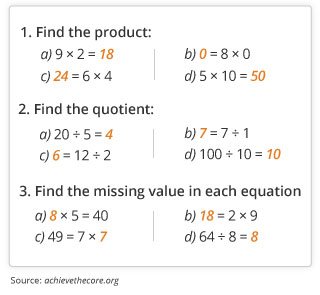
Think of division as the reverse of multiplication: it means dividing a whole into equal parts. Students will be expected to solve problems to show they understand the concept behind division.
Sample problem 2: Understanding division
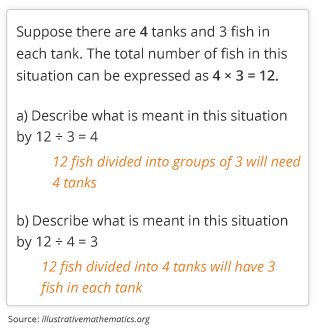
Third graders need to be able to read a word problem, decide which operation to use (+, -, x, ÷), write the equation, and calculate the answer. Questions like the sample problem below ask your child to write equations and draw visuals to show their thinking. These visuals and equations help parents and teachers see where a student may have gotten tripped up: understanding the question, writing the equation, and/or calculating the answer.
Watch third graders explain the concept of division.

Sample problem 3: Multiplying and dividing to solve problems
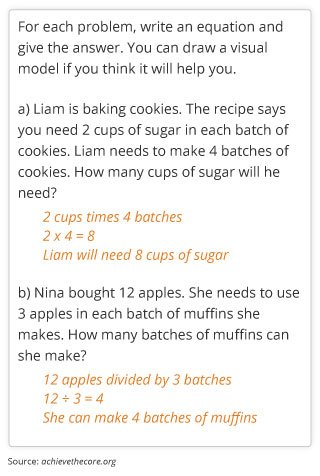
Third graders need to understand the concept of fractions and know that a whole that is divided into 2, 3, 4, 6, or 8 equal pieces makes halves, thirds, quarters, sixths, or eighths.
Sample problem 4: Understanding fractions as a concept
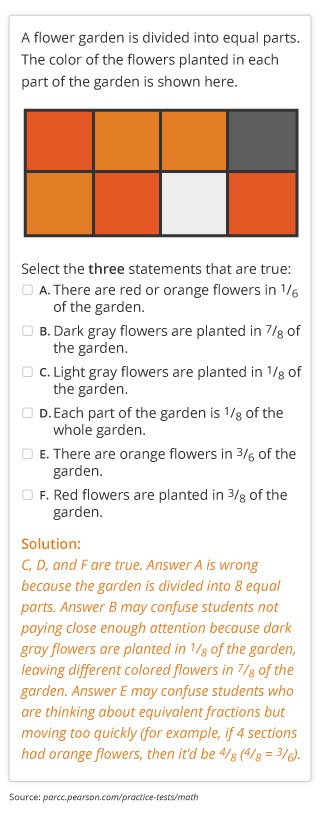
Third graders also need to know that two different fractions can express the same value; these are called equivalent fractions. Your child should be able to produce equivalent fractions, such as 1⁄4 = 2⁄8, and compare different fractions with the same denominator (the bottom number) or the same numerator (the top number).
Sample problem 5: Comparing fractions
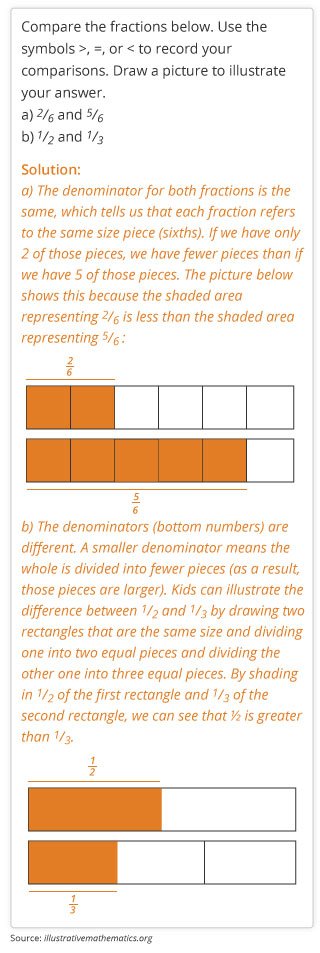
Third graders should be able to accurately place fractions like 1⁄4, 1⁄2, and 3⁄4 on the same number line.
Sample problem 6: Placing fractions on a number line
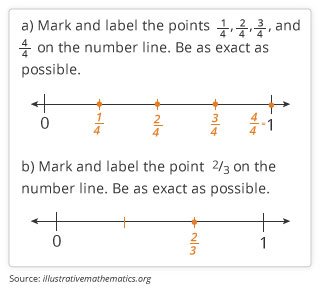
Third graders need to understand — and calculate — both the perimeter and the area of a rectangle. Perimeter is the total length of the outside of the rectangle, so students need to add up the lengths of all four sides. Area is the total space inside the shape, so students need to multiply the shape’s length by its width. At first, students are taught to find area by counting the “blocks” inside of the shape so they can visualize the area they’re calculating. Then, students learn to multiply numbers representing the length and the width to find a rectangle’s area. Finally, students are asked to use what they know about area to find the area of shapes made up of multiple rectangles.
Sample problem 7: Finding the area of a rectangle

Sample problem 8: Finding the area of shapes made up of multiple rectangles
Third graders are asked to solve more complicated area problems that involve more than one rectangle in a figure. In these problems, third graders are expected to find the area of each rectangle and then add those areas together to find the area of the entire shape. In the sample problem below, the area of the bottom portion is 3 cm x 3 cm = 9 cm2; the area of the top portion of the figure is 2 cm x 5 cm = 10 cm2. Added together, 9 cm2 + 10 cm2 = 19 cm2, which is the total area of the figure. Notice how students need to add the lengths 2 cm + 3 cm to find the 5 cm length of the top portion of the figure. This is common in problems like these.
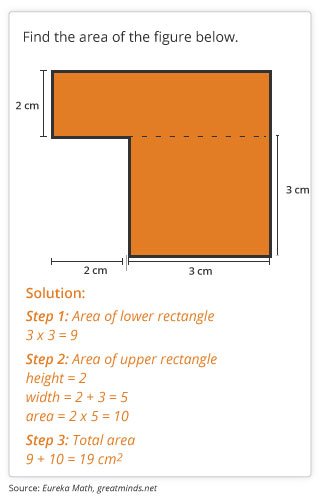
Kids are asked to use what they know about the four operations to solve problems involving units of measurement, such as minutes, liters, inches, miles, and cups.
Sample problem 9: Solving problems involving measurement

Whether you’re a math whiz or a number-phobic person, research shows that a parent’s attitude is a big predictor of how well a child will do in math. If you love math, let it show! If you don’t, fake it. Saying things like, “I hate math” — or worse, “I don’t have the math gene” — is contagious. Be the most math-friendly, math-supporting example you can be for your child. It does make a difference.
Make a point of asking the teacher about your child’s math skills. When it comes to concepts (why) and procedures (how), what is your child doing well? What does your child struggle with? Ask the teacher how you can help at home.

Honestly, Additional and Supporting Content sounds a little like “feel free to ignore,” so we asked the experts to explain. This content is given less weight on the PARCC test. These skills support the Major Content for third grade and will set your child up for success in future grades.
Third graders need to be able to quickly and accurately add and subtract within 1,000. Kids aren’t expected to just see a problem like 987 – 240 and know it’s 747, but they are expected to be able to set up the problem correctly and get the right answer without much hesitation. These skills support the major skill of solving two-step problems.
Kids should understand that 7 x 60 is the same as 7 x 6 x 10. Since students should easily calculate 7 x 6 = 42, they should use their understanding of place value to know that 42 x 10 = 420.
Students need to learn how to create simple bar graphs and picture graphs and use the information in them to solve one- and two-step problems. For example, a student may draw a graph showing how many kids were in class each day of the week and then be able to use their graph to answer the question How many more students were in school on Wednesday than on Monday?
In third grade, students learn to classify two-dimensional shapes by their properties. For example, all shapes with four sides are quadrilaterals. Students learn to draw shapes with specific dimensions and characteristics. For example, the teacher may ask your child to draw a parallelogram that is not a rectangle: a shape with two long sides that are the same length and two short sides that are the same length.
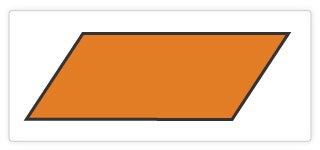
Back in 1992, the first talking Barbie actually said, “Math class is tough.” Educators took Mattel to task because math anxiety is something you can catch — and Barbie stopped saying it. Be like that better Barbie: don’t dis math.
The teacher sees your child every day, grades his homework and tests, and observes his participation in class. Ask the teacher to share her unique perspective on your child’s math skills. Start by asking about how your child is doing this year, and then ask how well your child is set up for math success next year, too.

Third graders are expected to do more than find the answer. They’re expected to explain how they got the answer and why their solution works. This means students should be able to describe the steps needed to solve the problem, show their work, and explain why their approach makes sense.
The process of explaining their work shows whether students understand the logic involved in solving a math problem. When kids understand the logic behind one solution, they are more likely to be able to solve other problems that require similar logic. For example, if a problem asks your child to calculate the height of a five-story building, and each of the stories is 9 feet high, your child should be able to explain why multiplying 5 x 9 to get the building’s height is faster than (but the same as) adding 9 + 9 + 9 + 9 + 9.
To defend their work, third graders are expected to explain how the four operations (+, -, x, ÷) work and how they relate to each other. For example: the reverse of the equation 21 + 45 = 66 is 66 – 45 = 21. Likewise, 3 x 9 = 27 is the reverse of 27 ÷ 9 = 3.
Students also need to explain their work using diagrams, such as graphs, charts, tables, and number lines.
Third graders learn to use these reasoning skills to evaluate their classmates’ work and explain (nicely) why someone else’s answer is correct or incorrect.
This year, your child will face questions that require new problem-solving skills. (Your child’s teacher may call this mathematical thinking.)
To tackle these problems, your child needs to figure out what she’s being asked to find and then whether to add, subtract, multiply, or divide. These problems often involve two steps, such as adding two things together and then using that sum in a division problem.
Explaining reasoning
Students may be asked to explain their answer in writing, as in the sample problem below.
Sample problem 1: Explaining reasoning
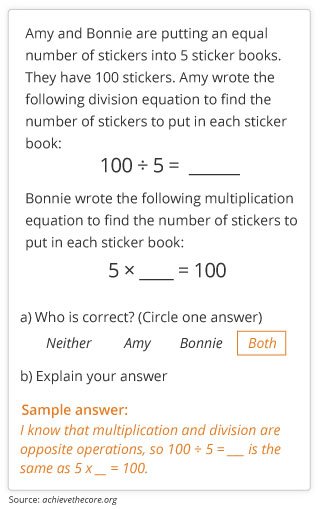
Critiquing someone else’s answer
In the classroom, third graders are expected to critique their classmates’ reasoning. They need to be able to explain why they agree or disagree. In the sample problem below, students are asked to provide an argument for why they agree or disagree.
Sample problem 2: Critiquing someone else’s answer

Who hasn’t muttered about math at least once? But, for the sake of your children, flip those feelings around. When parents say positive things about math, kids feel more capable and confident — and they tend to succeed at higher rates.
Ask your child’s teacher how students in the class practice explaining their thinking. Are there any activities you can try at home with your child?

Modeling and Application means taking a real-world problem and using math to solve it. By the end of third grade, students should be able to look at numbers that represent data in charts, graphs, and tables and understand the relationship between the quantities. For example, your child may review a table of student enrollment numbers at three different schools and then list the schools in order from highest to lowest enrollment. Another example might be: To answer the question If a runner has run two miles of a 10-mile race, how many more miles of the race remain? A third grader would be expected to draw the scenario, figure out the steps to answer the question, set up the equation, and then solve it.
Students should be comfortable creating models to understand and solve real-world problems.
Sample problem 1: Creating a model
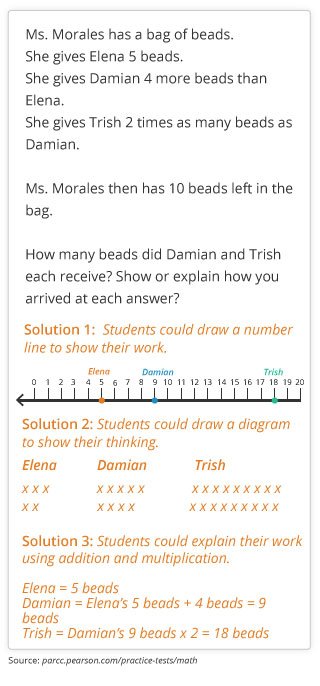
Watch how third graders work through word problems.

By the end of third grade, your child should be able to interpret simple charts, graphs, tables, and diagrams. Kids need to use this information to decide how to answer questions and solve problems.
Sample problem 2: Using models
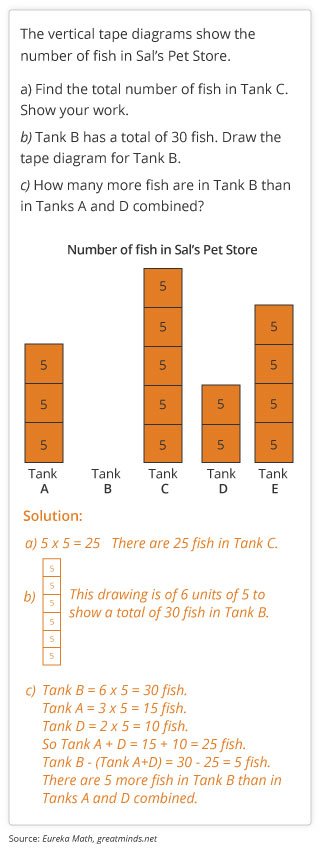
A key skill in working with models (charts, drawings, graphs, equations, etc.) is reviewing them to make sure they represent information correctly. Sometimes kids will be asked to fix the model. Other times, they’ll be asked to identify which model is right.
Sample problem 3: Evaluating the model

Math can be fun when you find it in the right places. Talk to your child about the math that’s hidden in his hobbies and interests. Sports, cooking, video games, arts and crafts — you can find math in almost any activity if you look for it!
Asking specific questions makes it easier to talk about math. Ask your child’s teacher: What’s an example of a modeling math problem that my child is doing right now? Can you show me? Please share two math problems that test my child’s ability to think through a challenging problem without giving up. Using specific examples can help you and the teacher focus on what your child needs to work on.

GreatKids created this guide to help you understand your child's state test scores and to support your child's learning all year long. We worked with PARCC and leading teachers in every grade to break down what your child needs to know and exactly how you can help